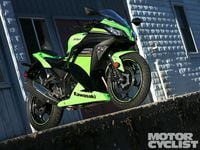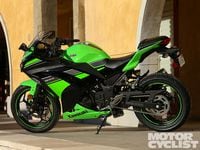They say: "The Ultimate Lightweight Sportbike."
We say: "Hey, they may be right!"
The defining moment during the press launch of the 2013 Kawasaki Ninja 300 happened on the last leg of the full-day ride. Kawasaki had a 2012 Ninja 250R along for comparison purposes, and this was my first opportunity to get on the old bike. As we jetted off from the last photo stop along Scaggs Creek Road, the group settled on the same pace we’d held all day—sporty but safe. Only I realized that I was working a lot harder on the 250 just to keep my place in line. A few miles down the road, it became obvious that I had to anticipate every time the guys ahead got on the gas, and twist the 250’s throttle sooner. Any miscue on gear choice, the slightest slack in aggression would see them pull inexorably ahead. I found myself hoping for a downhill segment or a mistake on someone’s part for an opportunity to close the gap.
Yes, the Ninja 300 is that different.
You wouldn’t think that a 7.8mm increase in stroke would count for much. But the engine, which shares the basic configuration and half the parts with its predecessor, has such a different personality that you could convince yourself it’s a new mill. In addition to the stroke increase, netting a total displacement of 296cc, the Ninja’s powerplant dumps carburetors for electronic fuel injection and 32mm throttle bodies. In return, it gains a new crankshaft and reworked counterbalance, plus new, lighter pistons to help maintain the same 13,000-rpm redline as before.
As soon as the starter motor lets go, it’s obvious something’s different down below. The 300 idles smoothly but revs with a diminutive roar, a small person with an unexpectedly gravelly voice. Pull in the very light clutch—its springs are softer because of a combined slipper/assist design that improves clamping force without abusing your left hand—select first and it’ll pull away with just a handful of revs. The Ninja feels like it has less flywheel than the single-cylinder Honda CBR250R, so it takes a bit more throttle to maintain revs once the clutch bites, but then it starts to make instant headway. Adequate power comes on as low as 3000 rpm, but then starts to pull smartly by 5000. All of the fun lives between 9000 and 12,000 rpm—there’s a noticeable flattening of power near the redline—but if you find yourself anticipating poorly and try to exit a corner at 5000 rpm, it’ll still pull up onto the powerband. Try that on the 250 and you’ll be looking to see if you’ve mistakenly clomped your right boot on the brake pedal instead of the peg.
Yes, the Ninja 300 is that different.
While the chassis has received a few minor alterations, including slightly altered damping in the nonadjustable, 37mm conventional fork, it’s a familiar experience. Kawasaki says 379 pounds ready to ride (4.5-gallon fuel tank full), some 22 lbs. more than the CBR250, but that difference is in the noise: First and lasting impressions are of a delightfully featherweight bike, with a compact riding position and near-instant steering response. If you’ve been riding one of those overweight liter-class supersports, the Ninja feels almost ridiculously small and light. Like you could hoist it over a curb with one hand, maybe clean-and-jerk it over your head. Specs watchers will carp about the greater seat height of the Ninja compared to the Honda (all of 0.4 in., at 30.9 in.) but the cut of the Kawasaki’s seat ensures flat-footing at stops yet preserves comfort.
Kawasaki is confident that the 300 will distance itself from both its own 250 and the popular Honda one-lunger. So confident that the price differential doesn’t seem to be a concern: The Ninja 300 starts at $4799. A lime-green Special Edition model is $200 more. ABS, a super-compact system that fits under the fuel tank, adds just 5 lbs. and $500 to the SE’s price; ABS is available only in SE trim.
Experienced riders used to diss the littlest Ninja as a pure beginner’s bike, something easily outgrown. Those same riders on board the 300 will return from a road like Scaggs Springs pie-eyed and singing the praises of small-displacement motorcycles.
Yes, the Ninja 300 is that different.
__**VERDICT: 4.5 out of 5 stars
Resetting our expectations of what a small-displacement sportbike can be.**

















/cloudfront-us-east-1.images.arcpublishing.com/octane/QCZEPHQAMRHZPLHTDJBIJVWL3M.jpg)
/cloudfront-us-east-1.images.arcpublishing.com/octane/HXOUJXQWA5HBHGRO3EMJIGFMVI.jpg)

/cloudfront-us-east-1.images.arcpublishing.com/octane/3TIWWRV4JBBOLDVGRYECVVTA7Y.jpg)
/cloudfront-us-east-1.images.arcpublishing.com/octane/KIX5O23D5NAIBGFXBN3327DKZU.jpg)
/cloudfront-us-east-1.images.arcpublishing.com/octane/7GJYDUIPXRGMTMQKN6ONYOLBOU.jpg)
/cloudfront-us-east-1.images.arcpublishing.com/octane/MUQLOVLL2ZDGFH25ILABNBXKTI.jpg)
/cloudfront-us-east-1.images.arcpublishing.com/octane/TNOU5DNE2BC57MFPMGN2EIDXAM.jpg)
/cloudfront-us-east-1.images.arcpublishing.com/octane/GTCXACQGJ5HAPDTGWUQKDEH44E.jpg)
/cloudfront-us-east-1.images.arcpublishing.com/octane/S35YGSEMEZB4BLTDJTSZPF4GLA.jpg)
/cloudfront-us-east-1.images.arcpublishing.com/octane/5UOT6HPX2JFMRJAX6EH45AR4MQ.jpg)
/cloudfront-us-east-1.images.arcpublishing.com/octane/OKWOJWAKP5EP3OACCRRWPCIX2Q.jpg)
/cloudfront-us-east-1.images.arcpublishing.com/octane/2WF3SCE3NFBQXLDNJM7KMXA45E.jpg)
/cloudfront-us-east-1.images.arcpublishing.com/octane/G4MG6OUCJNBSHIS2MVVOTPX65E.jpg)
/cloudfront-us-east-1.images.arcpublishing.com/octane/IIGGWFOTOJGB7DB6DGBXCCMTDY.jpg)
/cloudfront-us-east-1.images.arcpublishing.com/octane/QSTCM6AVEZA5JJBUXNIQ3DSOF4.jpg)
/cloudfront-us-east-1.images.arcpublishing.com/octane/U4I7G625B5DMLF2DVIJDFZVV6M.jpg)
/cloudfront-us-east-1.images.arcpublishing.com/octane/B6XD6LS6IVCQPIU6HXDJSM3FHY.jpg)
/cloudfront-us-east-1.images.arcpublishing.com/octane/ICL63FEDDRDTTMINYICCEYGMDA.jpg)
/cloudfront-us-east-1.images.arcpublishing.com/octane/FCGZHQXRBZFLBAPC5SDIQLVF4I.jpg)
/cloudfront-us-east-1.images.arcpublishing.com/octane/WNOB6LDOIFFHJKPSVIWDYUGOPM.jpg)

/cloudfront-us-east-1.images.arcpublishing.com/octane/X33NU3E525ECRHXLNUJN2FTRKI.jpg)
/cloudfront-us-east-1.images.arcpublishing.com/octane/6KKT5NNL2JAVBOXMZYS5ZO76YA.jpg)